Figure 4. Unrestricted activation of JNK during cell cycle progression regulates Wee1’s levels, Cdk1 activity, and entry into mitosis.
(A) Biochemical cell cycle analyses of HFF-1 cells transfected with empty plasmid (Control), JNK2 wild-type (wt) or the JNK2ΔKEN mutant after DTB and release. Levels of overexpressed FLAG-tagged JNKs were analyzed by immunoblot together with levels of cyclin B1, phosphorylated-histone H3 at Serine 10 (p-histone H3) and tubulin (as loading control). Immunokinase assays of JNK (using GST-Nt-c-Jun as substrate) and Cdk1 (using a 6×His-tagged kinase-dead Wee1 as substrate) were performed. FACS data is included in Figure S4A. (B) Similar experiments as described in (A) but using HeLa cells. Levels of overexpressed FLAG-tagged JNKs were analyzed by immunoblot together with levels of cyclin B1, Wee1 and actin (as loading control). Immunokinase assays of JNK (using GST-Nt-c-Jun as substrate) and Cdk1 (using histone H1 as substrate) were performed. (A and B) Degradation pattern of JNK2-wt along the cell cycle is not obvious due to the efficient expression of JNK2 when using the pEF-FLAG plasmid (see Figures S1D–E for details). (C) Flow cytometry cell cycle analyses performed in HFF-1 cells overexpressing the indicated constructs under the stated treatments (noc: nocodazole treatment −18 hours). The percentage of cells in G1, S, and G2/M (a mixed population of cells in G2 and mitosis) phases of the cell cycle are included for one representative experiment. Experiments were repeated at least three times. Uncropped images for key results of this figure are shown in Figure S7.

